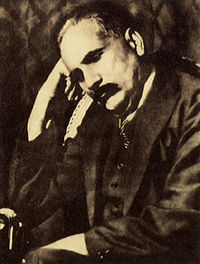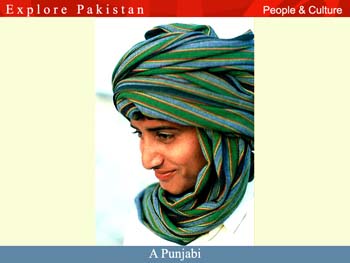|
[Ethnic
Groups] [The
Baloch] [People
of Sindh] [People
of Punjab] [Saraiki
People] [Pashtuns
People] [Muhajir
Urdu-Speaking People] [Mountain
Tribes] [Religions]
[Languages]
[Festivals]
[Arts
& Culture] [Folktales
From Pakistan] [Music
& Dance] [Art
& Craft] [Art
Gallries & Museums] [Cuisine
of Pakistan] [National
Symbols of Pakistan] [Slide
Show]
PEOPLE OF PUNJAB: THE PUNJABI
The Punjabi people (Punjabi:ਪੰਜਾਬੀ ,پنجابی also Panjabi people) are
an Indo-Aryan ethnic group from South Asia. They originate from the
Punjab region, which has been host to some of the oldest
civilizations in the world including one of the world's first and
oldest civilizations, the Indus Valley Civilization. The Punjabi
identity is primarily cultural and linguistic, with Punjabis being
those whose first language is Punjabi, an Indo-European and
Indo-Scythian tongue. In recent times, however, the definition has
been broadened to include also emigrants of Punjabi descent who
maintain Punjabi cultural traditions, even when they no longer speak
the language.

Allama Dr. Sir
Mohammad Iqbal
علامہ محمد اقبال
Punjabis are mostly and primarily found
in the Punjab region, of India and Pakistan, which forms the present
Indian state of Punjab and Pakistan province of Punjab , this is
because the Punjab region was divided between the two nations at
independence from Britain. In Pakistan, Punjabis comprise the
largest ethnic group at roughly 60% of the total population of the
country and reside predominantly in the province of Punjab and Azad
Kashmir. In India, Punjabis represent about 3% of the population.
The majority of Punjabi-speaking people in India can be found across
the greater Punjab region which comprises the states of Punjab,
Haryana, Himachal Pradesh, Delhi and the Union Territory of
Chandigarh. Besides these, large communities are also found in the
Jammu region of Jammu and Kashmir and the Indian states of
Rajasthan, Uttaranchal and Uttar Pradesh.
Punjabi is the dominant language spoken in Pakistan, and 11th most
spoken language in India and 3rd most spoken language in South Asia.
According to the Ethnologue 2005 estimate[5], there are 88 million
native speakers of the Punjabi language, which makes it
approximately the 11th most widely spoken language in the world.
According to the 2008 Census of Pakistan[6], there are approximately
76,335,300 native speakers of Punjabi in Pakistan, and according to
the Census of India, there are over 29,102,477 Punjabi speakers in
India[7]. Punjabi is also spoken as a minority language in several
other countries where Punjabis have emigrated in large numbers, such
as the United Kingdom (where it is the second most commonly used
language[8]) and Canada, where in recent times Punjabi has grown
fast and has now become the fourth most spoken language.[9]. Punjabi
is the 2nd most common language in the UK after English. The 4th
most common spoken language in Canada after English, French and
Chinese. There are also sizable communities in United States, Kenya,
Tanzania, Uganda, Persian Gulf countries, Hong Kong, Malaysia,
Singapore, Australia and New Zealand.
Punjabis are ethno-linguistically and culturally related to the
other Indo-Aryan peoples of South Asia. There are an estimated 120
million Punjabis around the world.
Pakistani Punjabis
Punjabis make up almost 45% of the population of Pakistan. The
Punjabis found in Pakistan belong to groups known as biradaris,
which descend from a common male ancestor. In addition, Punjabi
society is divided into two divisions, the zamindar groups or qoums,
traditionaly associated with farming and the moeens, who are
traditionally artisans. Zamindars are further divided into qoums
that claim pre-Islamic ancestry such as the Rajput, Jat, Shaikhs or
(Muslim Khatri), Kambohs, Gujjars, Dogars and Rahmani (Muslim Labana).
Zamindar groups claiming Central Asian or Middle Eastern ancestry
include the Gakhars, Khattar, Awan, Mughal and Arain, comprising the
main tribes in the north of the province, while Khagga, Bodla,
Jhandir, Daudpota, Gardezi, Syed and Quraishi are found in the
south, all of whom claim Arab ancestry. Immigrants from neighbouring
regions, such as the Kashmiri, Pashtun and Baluch ,also form
important element in the Punjabi population. Pashtun tribes like the
Niazis and the Khakwanis, are integrated into Punjabi village life.
Especially the members of the Niazi tribe, who see themselves as
Punjabis first. They have big communities in Mianwali, Bakkar,
Lahore, Faisalabad, Sahiwal and Toba Tek Singh. Major Moeen groups
include the Lohar, Khateek, Rawal, Chhimba Darzi, Teli, Julaha,
Mallaah, Mirasi and Muslim Shaikhs, who are associated with a
particular crafts or occupation.

Punjabis have traditionally and historically been farmers and
soldiers, which has transferred into modern times with their
dominance of agriculture and military fields in Pakistan. In
addition, Punjabis in Pakistan have been quite prominent
politically, having had many elected Members of Parliament. As the
most ardent supporters of a Pakistani state, the Punjabis in
Pakistan have shown a strong predilection towards the adoption of
the Urdu language but nearly all speak Punjabi, and still identify
themselves as ethnic Punjabis for the most part. Religious
homogeneity remains elusive as a predominant Islamic Sunni-Shia
population and a Christian minority have not completely wiped out
diversity since the partition of British India. A variety of related
sub-groups exist in Pakistan and are often considered by many
Pakistani Punjabis to be simply regional Punjabis including the
Seraikis (who overlap and are often considered transitional with the
Sindhis) and Punjabi Pathans (which publications like Encyclopędia
Britannica consider a transitional group between Punjabis and
Pathans.
Language:
Due to vast area of land where Punjabi is spoken, different local
variations or dialects have developed.
Majhi: Spoken in the heart of Punjab i.e., Lahore , Sialkot,
Gujaranwala, Gurdaspur, Amritsar. Most of the population of Punjab
lives in this area and linguists also say that Majhi dialect is the
"Tixali boli" i.e., it has been influenced by all other dialects.
Malwi: Spoken in the east Punjab area of Ludhiana, Ambala,
Bathinda, Ganganagar, Maleerkotla Fazilka, Ferozepur. This area (Malwa)
is the southern and central part of present day Indian Punjab. Also
includes the Punjabi speaking areas of Haryana, viz. Ambala, Hissar,
Sirsa, Kurukhetra etc. (northern parts of Haryana mainly).
Doabi: Land between the rivers of Beas and Satluj is called
Doaba. Do Aaba lierally means "the land between two waters" in
Persian. It includes Jalandhar, Hoshiarpur, and large number of
Punjabis from this area have gone out to U.K., USA, Canada or
elsewhere.
Pothohari: The area where Pothohari is spoken extends in the
north from Kashmir to as far south as Jehlum and Gujar Khan and
includes the capital of Pakistan, Islamabad. The whole area (i.e.
the north-west of Punjab) is beautiful scenic area. It's here that
the beautiful hilly resorts of Murree, Ayubia, Nathia-Gali lies.
This dialect is similar to some extent to the Hindko dialect of
Punjabi which is spoken in Peshawar, Nowshehra, Mansehra all these
areas lie in the North West Frontier Province of Pakistan where
majority language is Pashto, but Hindko speakers area also found in
sizable numbers.
Jhangvi: The region where Jhangvi is spoken stretches from
Khanewal to Jhang and includes the cities of Faisalabad, Chiniot.
Jhangvi dialect is also called the "Jangli" dialect of Punjabi. This
is the land of Heer/Ranjha. Their tomb is located in Jhang city.
Sultan Bahu is an important saint of this area.
Multani: The dialect spoken in Multan, Bahawalpur, Khairpur,
Daira Ghazi Khan, Muzafar Garh i.e., southern deserts of Punjab is
called Multani (also Lehndi by some) and perhaps differs from
Punjabi more than any other dialect. This is the land of Muslim
Sufis, perhaps "Shah Shams Sabazwari" who came to Multan in 1165 AD
was the first in a long series of Sufis to base themselves in Multan.
Clothing: Women's clothing normally consists of a piece of
colorful cloth that women wear around their necks. Salwar kameez's
and duppattas come in a variety of colors and designs. Many stores
specialize and sell only these articles of clothing. Men and boys
generally wear loose pants or slacks with a collared shirt or
t-shirt. Some males also wear the kurta pajama, a shirt and pant
outfit, especially the Punjabi farmer. On their head, many Sikhs
also wear bhuggs, or turbins. In winter, both women and men
generally wear a woolen shawl, a small blanket, around their necks.
Many men wear jackets and woolen caps as well.
Music: There are many different varieties of Punjabi music.
Traditional Punjabi music includes instruments such as the dhol
drum, flute, dholak, and tumbi. Singers such as Pathanay Khan mainly
based his music on the dholak and tumbi. Many other artists use dhol
drum as their primary instrument. People generally refer to Punjabi
music based on the dhol drum as Bhangra. These days, besides using
the traditional instruments, some artists use computers and Western
instruments to accompany their Bhangra music. Many races of people
and religions made up the cultural heritage of the Punjab. Punjab is
the land where spiritual aspirations arose. This heroic land bore
numerous invasions, and after all its suffering, did not entirely
lose its glory and its strength.
|